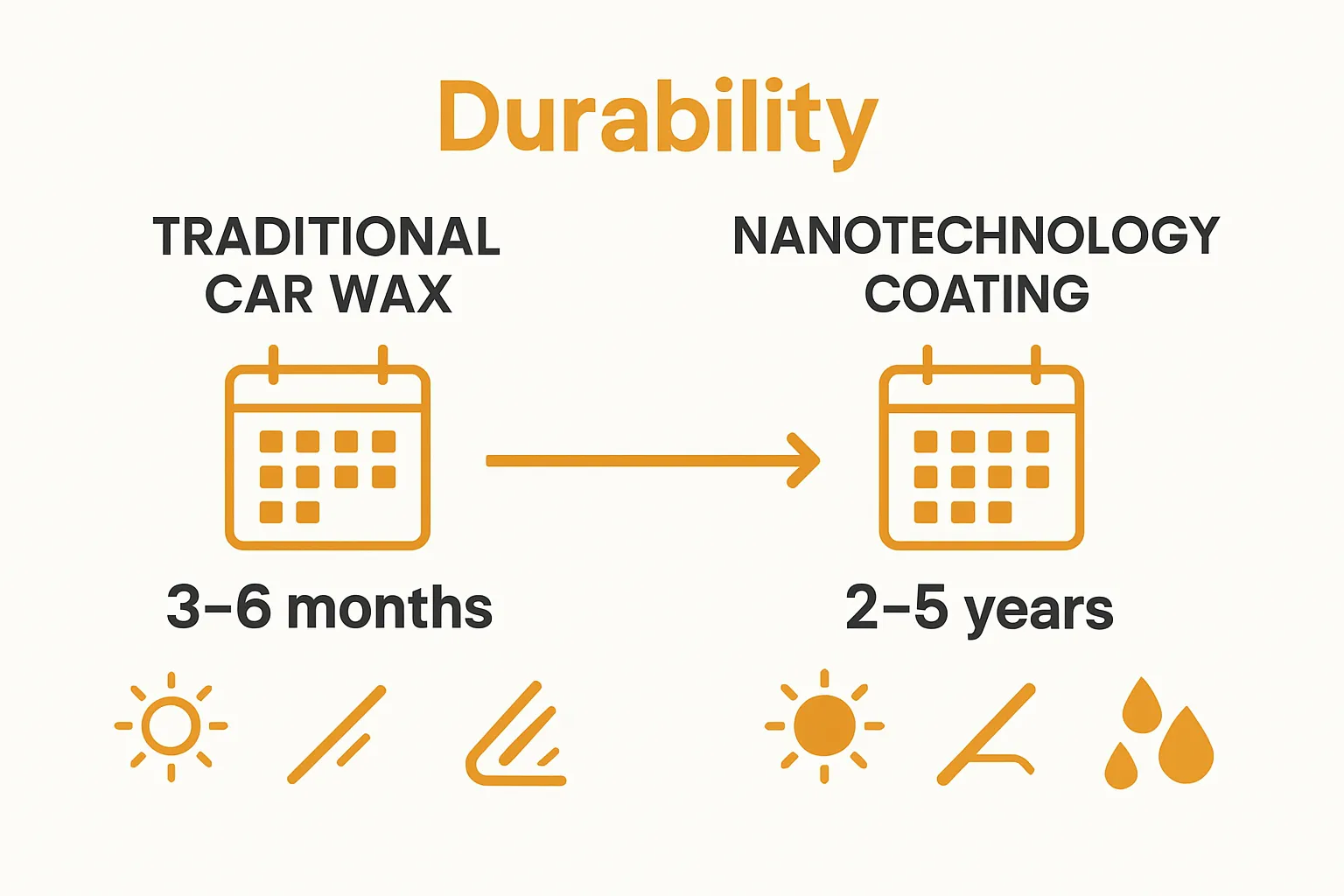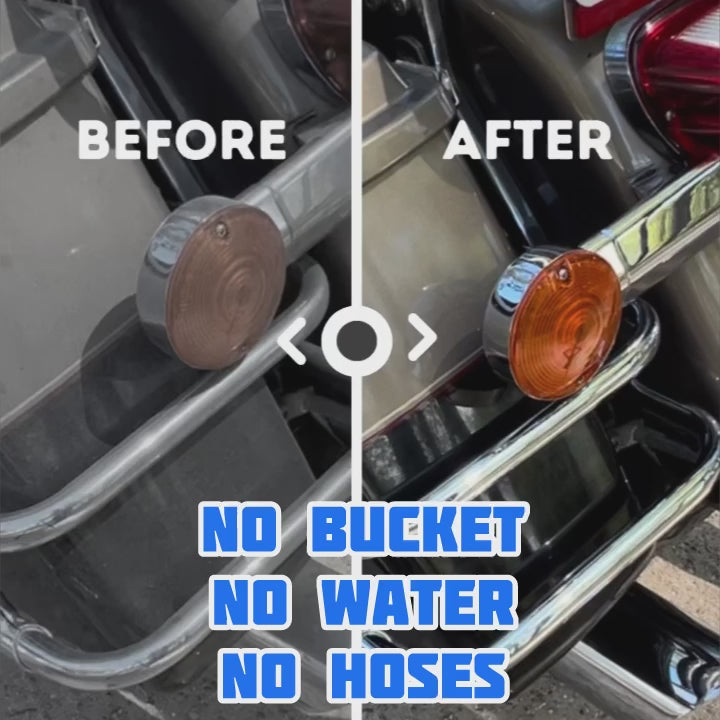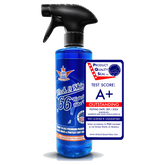Understanding the Role of Nanotechnology in Car Care
Nanotechnology sounds like something straight out of science fiction but it is already transforming how we care for cars in ways most people never notice. Most car owners are shocked to learn that a single nanoscale coating can repel dirt, water, and UV rays while bonding directly to the paint at the molecular level. What surprises even more is that these microscopic innovations not only keep cars cleaner for longer but also slash maintenance costs and boost performance in ways no traditional wax or polish can come close to matching.
Table of Contents
- What Is Nanotechnology And Its Relevance To Cars?
- Why Nanotechnology Matters In Car Care Solutions
- How Nanotechnology Works To Protect Vehicle Surfaces
- Key Concepts Behind Nanotechnology In Automotive Care
- Real-World Applications Of Nanotechnology In Car Maintenance
Quick Summary
| Takeaway | Explanation |
|---|---|
| Nanotechnology enhances vehicle performance | It reduces engine friction and improves fuel efficiency, leading to better overall vehicle operation. |
| Advanced coatings provide superior protection | Nanoscale coatings create molecular shields that resist UV damage, chemicals, and minor scratches, enhancing longevity. |
| Self-cleaning surfaces minimize maintenance | Nanoscale coatings exhibit hydrophobic properties that repel dirt and contaminants, reducing cleaning frequency. |
| Molecular bonding improves adhesion | Protective coatings bond at the molecular level, ensuring durability and resistance to environmental stressors. |
| Proactive maintenance extends vehicle life | By utilizing nanotechnology, car owners can prevent degradation rather than waiting for damage to occur, preserving vehicle integrity. |
What is Nanotechnology and Its Relevance to Cars?
Nanotechnology represents a groundbreaking scientific approach that manipulates matter at an incredibly microscopic scale. At its core, nanotechnology involves engineering and controlling materials at the nanometer level - which is roughly one billionth of a meter. This incredibly precise manipulation allows scientists and engineers to create revolutionary solutions with extraordinary properties that dramatically transform traditional material capabilities.
Understanding Nanoscale Engineering
At the nanoscale, materials exhibit unique characteristics that differ substantially from their larger counterparts. Researchers can engineer surfaces and coatings with unprecedented precision, enabling remarkable improvements in durability, performance, and protection. In automotive applications, nanotechnology offers transformative potential for enhancing vehicle surfaces, reducing friction, preventing damage, and creating more resilient protective layers.
our guide on nano ceramic coatings provides deeper insights into how these microscopic engineering techniques can revolutionize car care. By restructuring material properties at the atomic level, nanotechnology enables unprecedented levels of surface protection and performance enhancement.
Practical Applications in Automotive Care
In automotive contexts, nanotechnology finds remarkable applications across multiple domains. According to research from the U.S. Department of Energy, nanomaterials can significantly improve vehicle components by:
- Reducing friction in engine components
- Creating more durable and scratch resistant paint finishes
- Developing advanced protective coatings that repel water, dirt, and environmental contaminants
- Enhancing thermal management in vehicle systems
These nanoscale innovations translate into tangible benefits for car owners: longer lasting vehicles, improved fuel efficiency, reduced maintenance costs, and superior aesthetic preservation.
To clarify how nanotechnology differs from traditional car care, the following table compares key features of each approach.
| Feature / Benefit | Traditional Car Care | Nanotechnology Car Care |
|---|---|---|
| Surface Protection | Sits on surface, wears off quickly | Bonds at molecular level, long-lasting |
| Resistance to Dirt & Water | Limited hydrophobic effect | Strong hydrophobic/self-cleaning |
| UV & Chemical Protection | Fades under sunlight or chemicals | High resistance to UV and chemicals |
| Cleaning & Maintenance Frequency | Frequent cleaning needed | Less frequent cleaning required |
| Durability | Months at best | Up to several years |
| Performance Enhancement | Minimal | Improved efficiency and reduced friction |
| Cost Over Time | Higher due to repeated applications | Lower from reduced maintenance needs |
Why Nanotechnology Matters in Car Care Solutions
Nanotechnology represents a paradigm shift in automotive maintenance and protection, offering solutions that go far beyond traditional approaches. By leveraging microscopic engineering techniques, car care professionals and enthusiasts can achieve unprecedented levels of surface protection, performance enhancement, and long term vehicle preservation.
Superior Protection at the Molecular Level
Traditional car care methods often provide surface level protection that deteriorates quickly under environmental stress. Nanotechnology transforms this paradigm by creating protective layers that bond directly with vehicle surfaces at the molecular level. These nanoscale coatings create hydrophobic and self-cleaning properties that actively resist dirt, water, UV radiation, and chemical contaminants.
our guide on quick detailer techniques can help you understand how advanced surface protection strategies complement nanoscale innovations. By integrating these cutting edge technologies, car owners can maintain their vehicle’s aesthetic and functional integrity with minimal ongoing maintenance.
Economic and Performance Benefits
According to automotive materials research from MIT, nanotechnology delivers substantial economic advantages in automotive care:
- Dramatically reduced maintenance frequency
- Enhanced fuel efficiency through reduced surface friction
- Longer lasting protective coatings
- Superior resistance to environmental degradation
- Improved overall vehicle performance and longevity
These nanoscale innovations represent more than just incremental improvements.
 They fundamentally reimagine how we protect and maintain vehicles, offering car owners a sophisticated, scientifically advanced approach to automotive care that delivers measurable performance and economic benefits.
They fundamentally reimagine how we protect and maintain vehicles, offering car owners a sophisticated, scientifically advanced approach to automotive care that delivers measurable performance and economic benefits.
How Nanotechnology Works to Protect Vehicle Surfaces
Nanotechnology revolutionizes vehicle surface protection by manipulating materials at the molecular level, creating extraordinarily robust and intelligent protective systems. Unlike traditional coating methods, nanoscale engineering enables the creation of defensive layers that actively interact with environmental challenges, providing comprehensive and dynamic protection for automotive surfaces.
Molecular Bonding and Surface Interaction
At the nanoscale, protective coatings can develop extraordinary chemical bonds with vehicle surfaces. These microscopic structures create a seamless, integrated layer that does not simply sit on top of the paint or metal, but actually becomes part of the surface itself. This molecular integration ensures superior adhesion, durability, and resistance to environmental stressors.
our comprehensive guide on hydrophobic coatings explores how these advanced technologies create water repellent surfaces that actively prevent dirt and contaminant accumulation. By understanding these nanoscale mechanisms, car owners can appreciate the sophisticated science behind modern automotive protection.
Advanced Protective Mechanisms
According to nanotechnology research from Northwestern University, nanomaterial protective systems operate through several sophisticated mechanisms:
- Creating microscopic surface textures that prevent dirt adherence
- Developing chemical structures that actively repel water and organic contaminants
- Generating self-healing properties that can minimize minor surface scratches
- Establishing thermal and UV radiation resistance
- Providing exceptional chemical stability under diverse environmental conditions
These nanoscale protective strategies transform vehicle maintenance from a reactive to a proactive approach. By engineering surfaces at the molecular level, nanotechnology provides car owners with unprecedented levels of protection, ensuring that vehicles remain pristine and well maintained with minimal ongoing effort.
The following table summarizes the advanced protective mechanisms made possible by nanotechnology as described in the article.
| Protective Mechanism | Description |
|---|---|
| Microscopic Surface Textures | Prevent dirt and contaminant adherence |
| Chemical Water Repellency | Actively repels water and organic contaminants |
| Self-Healing Properties | Minimizes impact of minor surface scratches |
| UV and Thermal Resistance | Shields against ultraviolet rays and heat damage |
| Exceptional Chemical Stability | Maintains protection under diverse and harsh environments |
| Integrated Molecular Bonding | Seamlessly integrates with the vehicle surface for durability |
| Reduced Surface Friction | Lowers mechanical resistance, improving fuel economy |
Key Concepts Behind Nanotechnology in Automotive Care
Nanotechnology in automotive care represents a sophisticated scientific approach that transforms traditional surface protection strategies. By understanding the fundamental principles governing nanoscale interactions, car owners and professionals can leverage groundbreaking technologies that provide superior vehicle maintenance solutions.
Quantum Scale Material Engineering
At the nanoscale, materials exhibit extraordinary and counterintuitive properties that differ dramatically from their macroscopic counterparts. These unique characteristics emerge from quantum mechanical interactions, allowing scientists to design protective layers with unprecedented precision. By manipulating material structures at the molecular level, researchers can create coatings that actively respond to environmental challenges, rather than passively resisting them.
our comprehensive guide on glass coating technologies demonstrates how these advanced nanoscale principles translate into practical automotive protection solutions. Understanding these intricate engineering techniques helps car enthusiasts appreciate the scientific complexity behind modern surface treatments.
Functional Nanoparticle Design
According to nanotechnology research from the National Academies Press, functional nanoparticles in automotive applications are engineered with specific performance objectives:
- Developing enhanced surface adhesion mechanisms
- Creating multifunctional protective layers
- Generating self-cleaning and self-healing surfaces
- Establishing robust chemical and thermal resistance
- Minimizing surface friction and environmental degradation
These nanoscale innovations represent more than incremental improvements. They fundamentally reimagine how we conceptualize and implement automotive surface protection, offering car owners scientifically advanced solutions that deliver measurable performance, longevity, and aesthetic preservation.
Real-World Applications of Nanotechnology in Car Maintenance
Nanotechnology has transformed automotive maintenance from a reactive repair model to a proactive preservation strategy. By integrating microscopic engineering solutions across multiple vehicle systems, car owners can now achieve unprecedented levels of protection, performance, and longevity.
Comprehensive Surface Protection
Nanoscale coatings represent the frontline of automotive surface defense. These advanced treatments go far beyond traditional waxing or polishing, creating molecular shields that actively protect vehicle exteriors from environmental degradation. Nano-engineered protective layers can resist UV radiation, chemical contaminants, minor scratches, and oxidation with remarkable efficiency.
our comprehensive guide on polymer coatings provides deeper insights into how these advanced technologies work to preserve vehicle aesthetics and structural integrity. Understanding these innovative protection mechanisms helps car owners make informed maintenance decisions.

Advanced Performance Enhancement
According to automotive materials research from the Society of Automotive Engineers, nanotechnology delivers significant performance improvements across multiple automotive domains:
- Reducing engine friction through nano-engineered lubricants
- Improving fuel efficiency by minimizing mechanical resistance
- Enhancing thermal management in critical vehicle components
- Creating more responsive and durable brake system materials
- Developing lightweight yet stronger structural components
These nanoscale innovations demonstrate how microscopic engineering can deliver macro-level performance transformations. By reimagining vehicle maintenance at the molecular level, nanotechnology provides car owners with sophisticated, scientifically advanced solutions that extend vehicle life, improve performance, and reduce long term maintenance costs.
Ready to Experience the Power of Nanotechnology for Your Car?
Tired of dealing with fading paint, tough stains, or endless effort to keep your vehicle looking new? As discussed in the article, traditional car care often falls short because it cannot protect at the molecular level. Nanotechnology changes the game, offering coatings that bond directly with your car’s surface to deliver next-generation protection against dirt, UV rays, and daily wear. Discover our premium range of bestselling nanotech car care solutions designed to give your car a resilient shield and long-lasting shine.

Experience the difference that scientifically advanced protection makes. Visit ShinyKings.com today and see why so many car owners trust our world-unique sealants and coatings. It’s time to invest in smarter car care with products that work on a microscopic level. Check out our full automotive care collection and feel confident your car is protected now and into the future.
Frequently Asked Questions
What is nanotechnology in car care?
Nanotechnology in car care refers to the manipulation and engineering of materials at the nanometer scale to enhance vehicle surfaces and components. It enables the creation of protective coatings and treatments that offer superior durability, resistance to environmental factors, and improved performance compared to traditional methods.
How does nanotechnology improve vehicle performance?
Nanotechnology improves vehicle performance by reducing friction in engine components, creating lighter and stronger materials, and enhancing fuel efficiency. These advancements lead to longer-lasting vehicles and lower maintenance costs.
What are the benefits of using nanotechnology coatings on cars?
The benefits of nanotechnology coatings include superior protection against UV radiation, chemical contaminants, water, and dirt. These coatings bond at the molecular level, providing enhanced durability and self-cleaning properties, which help maintain the vehicle’s aesthetic and functional integrity over time.
Are nanotechnology products worth the investment for car maintenance?
Yes, nanotechnology products are often worth the investment as they provide long-term benefits such as reduced frequency of maintenance, improved vehicle longevity, and enhanced performance. Their advanced protective features help save money in the long run by reducing repair and upkeep needs.




